
TAUSEEF MUSTAFA
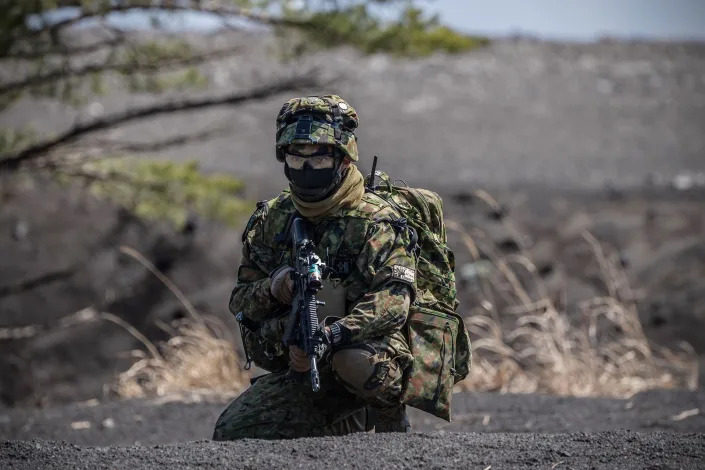
Vivek Raghuvanshi
Fri, December 23, 2022
NEW DELHI — India’s weapons buyer on Thursday approved a 843.28 billion rupees ($10.18 billion) budget for the acquisition of major weapons and platforms, most of which the government will spend locally in a bid to bolster the domestic defense manufacturing sector.
The Defence Ministry said in a statement that its Defence Acquisition Council backed the so-called acceptance of necessity proposal, which will see about 97.4% of the funds used to procure indigenous materiel. That type of proposal is the first stage for buying arms, per government regulations.
“This unprecedented initiative will not only modernise the armed forces but also provide a substantial boost to the defence industry to achieve the goal of ‘Aatmanirbhar Bharat’ or self-reliant India,” the ministry said.
The government is now expected to issue fresh tenders, followed by the selection of bidders, field trials of prototypes and existing systems, and ultimately the awarding of a contract. The induction of new arms would begin after 2030.
Under this latest budget, India is seeking light tanks, mounted gun systems, ballistic helmets for infantry troops and so-called futuristic infantry combat vehicles, the ministry said. The Army estimates it needs a total of 1,750 futuristic infantry combat vehicles, 350 light tanks and about 800 mounted gun systems.
No local company in India has ever built tanks, futuristic infantry combat vehicles, or 155mm/52-caliber mounted gun systems with fully indigenous technology.
The Indian Air Force is seeking air-to-ground next-generation anti-radiation missiles, long-range guided bombs, range-augmentation kits for conventional bombs, and advanced surveillance systems.
The Defence Acquisition Council also granted approval for new naval programs for anti-ship missiles, underwater autonomous vehicles and multipurpose vessels.
Similarly, the agency approved the procurement of an unspecified quantity of fully indigenous next-generation offshore patrol vessels for the Coast Guard.
In the 2021-2022 financial year, India bought 702. 21 billion rupees worth of locally made armaments from domestic defense contractors. During the 2022-2023 financial year, India has spent about 845.98 billion rupees on locally sourced materiel.
Japan Begins Defense Upgrade With 26% Spending Increase for 2023
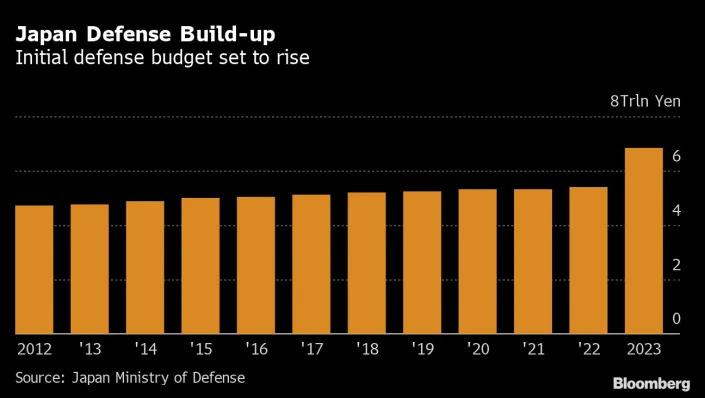
Isabel Reynolds
Fri, December 23, 2022
(Bloomberg) -- Japan will hike its defense spending by more than a quarter in 2023 to ¥6.82 trillion ($51.4 billion) as it begins a five-year program to toughen its security posture amid rising threats from China, North Korea and Russia.
The plans include acquiring missiles capable of striking neighboring countries, and the development of a new jet fighter with the UK and Italy. Japan will also stockpile ammunition, and bolster its Self-Defense Forces’ ability to quickly deploy troops and equipment to southwestern islands, where tensions with China are high.
Prime Minister Fumio Kishida’s cabinet approved the budget plan Friday after the government announced the security overhaul last week — abandoning a decades-old cap on defense spending of 1% of gross domestic product after Russia’s invasion of Ukraine spooked the public. The US welcomed the plans, but China and North Korea protested, while South Korea urged transparency.
Kishida’s spending plans also triggered a fight within his ruling Liberal Democratic Party over how to fund the expanded defense budget. While he vowed not to issue more bonds, construction bonds would be used to fund some purchases of ships and submarines, the Asahi newspaper reported Thursday without saying where it got the information.
The slump in the yen against the dollar over recent months means Japan’s cash won’t go as far when purchasing equipment from overseas. The ministry plans to bolster domestic capacity to produce ammunition and stockpile longer-range missiles. It will also seek to promote sales of domestically made equipment abroad.
Funds will also be earmarked for research and development of uncrewed aerial and underwater vehicles.
Japan’s shopping list includes more than ¥200 billion to acquire Raytheon Technologies Corp’s Tomahawk cruise missiles, which can be fired from ships, and about another ¥50 billion for air-to-surface missiles from Lockheed Martin Corp. and Norway’s Kongsberg Defence & Aerospace, according to documents provided by the Defense Ministry.
The following are some of the other items included in the budget:
¥2 trillion for maintenance of equipment, almost double the previous year’s figure
About ¥1 trillion for ships and planes to be used to quickly deploy troops to other parts of the country
¥828 billion for ammunition, about 3.3 times the amount spent the previous year
¥269 billion to improve working conditions for SDF personnel
¥250 billion to purchase 16 Lockheed Martin F-35 fighter jets
¥100 billion for joint development of the next-generation fighter with the UK and Italy
¥58.5 billion for research into hypersonic missiles
Tomahawks part of Japan's record defense spending next year
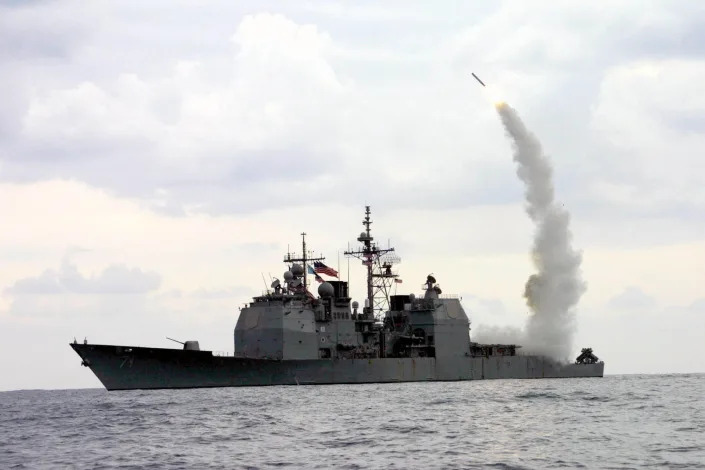
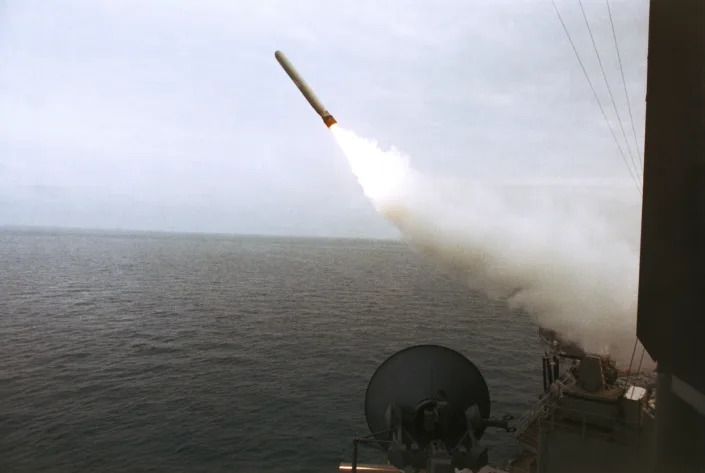
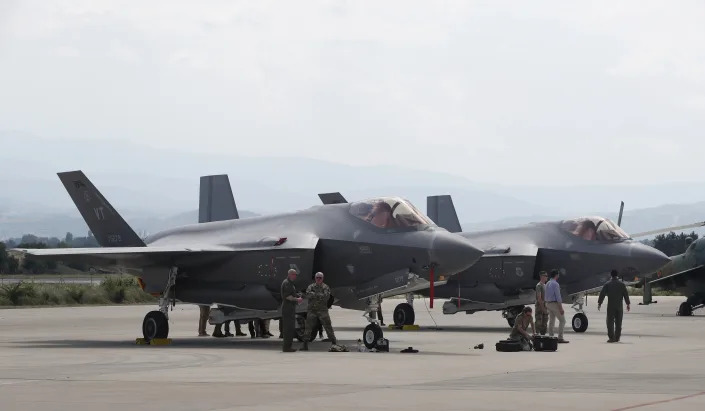
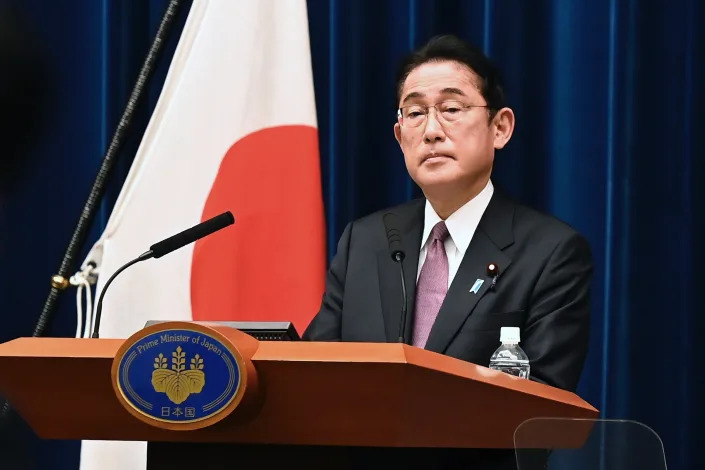
Japan's Prime Minister Fumio Kishida attends a news conference at the prime minister's official residence in Tokyo, on Dec. 16, 2022. Japan's defense spending will jump 20% to a record 6.8 trillion yen ($55 billion) next year as the country prepares to deploy U.S.-made Tomahawks and other long-range cruise missiles that can hit targets in China or North Korea under a more offensive security strategy.

Isabel Reynolds
Fri, December 23, 2022
(Bloomberg) -- Japan will hike its defense spending by more than a quarter in 2023 to ¥6.82 trillion ($51.4 billion) as it begins a five-year program to toughen its security posture amid rising threats from China, North Korea and Russia.
The plans include acquiring missiles capable of striking neighboring countries, and the development of a new jet fighter with the UK and Italy. Japan will also stockpile ammunition, and bolster its Self-Defense Forces’ ability to quickly deploy troops and equipment to southwestern islands, where tensions with China are high.
Prime Minister Fumio Kishida’s cabinet approved the budget plan Friday after the government announced the security overhaul last week — abandoning a decades-old cap on defense spending of 1% of gross domestic product after Russia’s invasion of Ukraine spooked the public. The US welcomed the plans, but China and North Korea protested, while South Korea urged transparency.
Kishida’s spending plans also triggered a fight within his ruling Liberal Democratic Party over how to fund the expanded defense budget. While he vowed not to issue more bonds, construction bonds would be used to fund some purchases of ships and submarines, the Asahi newspaper reported Thursday without saying where it got the information.
The slump in the yen against the dollar over recent months means Japan’s cash won’t go as far when purchasing equipment from overseas. The ministry plans to bolster domestic capacity to produce ammunition and stockpile longer-range missiles. It will also seek to promote sales of domestically made equipment abroad.
Funds will also be earmarked for research and development of uncrewed aerial and underwater vehicles.
Japan’s shopping list includes more than ¥200 billion to acquire Raytheon Technologies Corp’s Tomahawk cruise missiles, which can be fired from ships, and about another ¥50 billion for air-to-surface missiles from Lockheed Martin Corp. and Norway’s Kongsberg Defence & Aerospace, according to documents provided by the Defense Ministry.
The following are some of the other items included in the budget:
¥2 trillion for maintenance of equipment, almost double the previous year’s figure
About ¥1 trillion for ships and planes to be used to quickly deploy troops to other parts of the country
¥828 billion for ammunition, about 3.3 times the amount spent the previous year
¥269 billion to improve working conditions for SDF personnel
¥250 billion to purchase 16 Lockheed Martin F-35 fighter jets
¥100 billion for joint development of the next-generation fighter with the UK and Italy
¥58.5 billion for research into hypersonic missiles
Tomahawks part of Japan's record defense spending next year




Japan's Prime Minister Fumio Kishida attends a news conference at the prime minister's official residence in Tokyo, on Dec. 16, 2022. Japan's defense spending will jump 20% to a record 6.8 trillion yen ($55 billion) next year as the country prepares to deploy U.S.-made Tomahawks and other long-range cruise missiles that can hit targets in China or North Korea under a more offensive security strategy.
(David Mareuil/Pool Photo via AP, File)
MARI YAMAGUCHI
Fri, December 23, 2022
TOKYO (AP) — Japan's defense spending will jump 20% to a record 6.8 trillion yen ($55 billion) next year as the country prepares to deploy U.S.-made Tomahawks and other long-range cruise missiles that can hit targets in China or North Korea under a more offensive security strategy.
The planned purchase of Tomahawks at 211.3 billion yen ($1.6 billion) is a centerpiece of Japan's 2023 budget plan approved Friday by Prime Minister Fumio Kishida's Cabinet and shows his government's determination to rapidly arm itself with more strike capability under the new strategy.
Additionally, Japan will pay the United States 110 billion yen ($830 million) for equipment and software needed to launch Tomahawks, as well as fees for the technology transfer and staff training in the coming year, defense officials said.
The hefty budget plan, pending parliamentary approval, is the first installment of a five-year, 43-trillion-yen ($325-billion) military spending plan under the new defense buildup plan also announced last week. The new spending target follows the NATO standard and will eventually push Japan’s annual budget to about 10 trillion yen ($73 billion), the world’s third biggest after the United States and China.
The budget plan comes a week after Kishida's government announced Japan's new National Security Strategy, stating its determination to possess controversial “counterstrike capability” to preempt enemy attacks and nearly double its spending within the next five years to protect itself from growing risks from China, North Korea and Russia and escalating fear of a Taiwan emergency.
The strategy is a historic change from Japan’s exclusively self-defense policy since the end of World War II. China, with its rapid arms buildup, increasingly assertive military activity and rivalry with the U.S., presents “an unprecedented and the greatest strategic challenge” to the peace and security of Japan and the international community, the strategy stated.
Tomahawks will be deployed over two years from 2026 to 2027 on advanced Aegis radar-equipped destroyers with vertical launch systems for ship-to-surface attacks, defense officials said.
Japan will also buy more foreign-developed standoff missiles for launch from warplanes — a 500-kilometer- (310-mile-) range Joint Strike Missile from Norway for F-35A fighters, and Lockheed Martin’s Joint Air-to-Surface Standoff Missile with a range of about 900 kilometers (560 miles), for upgraded F-15s.
Japan will spend 94 billion yen ($710 million) next year to work on upgrading and mass production of Type-12 land-to-ship guided missiles develped by Mitsubishi Heavy Industries for deployment within the next few years.
To reinforce strike capability and range, Japan is adding eight more F-35Bs at 143.5 billion yen ($1.08 billion) capable of short takeoffs and vertical landing on either of the two formerly helicopter carriers Izumo and Kaga that are being retrofitted so they could be operated jointly with the U.S. military.
Over the next five years, Japan will spend about 5 trillion yen ($37 billion) on standoff, or long-range missiles, with deployment beginning in four years. Annual spending for 2023 on long-range ammunition alone will be tripled from this year to 828 billion yen ($6.26 billion).
Japan will develop other types of arsenals, such as hypersonic weapons and unmanned and multi-role vehicles for possible collaboration with the F-X next-generation fighter jet Japan is developing with Britain and Italy for deployment in 2035. The Defense Ministry is also developing arsenals designed for defending remote southern islands, including a Japanese-controlled East China Sea island disputed with China.
Japan in using strike-back capability needs to fully rely on the United States to detect early signs of attacks and determine targets because of a lack of high levels of intelligence and cybersecurity, experts say.
To address the concern, Japan will spend about 100 billion yen ($7.6 million) next year also to beef up cybersecurity to protect Japanese defense technology and industry.
Japan will also spend 220 billion yen ($1.7 billion) to build two compact destroyers to be equipped with Aegis radars to strengthen the country's missile interception capability as a deterrent to advanced missiles.
Another key purchase is unmanned aerial vehicles for assaults and reconnaissance. Defense officials said they plan to test a number of foreign-developed UAVs, including Turkish-made Bayraktar used in Ukraine, as well as those from Israel, the United States, as well as home-developed Fuji Imvac.
Japan says counterstrike capability is indispensable and constitutional if it’s in response to signs of an imminent enemy attack. But experts say it is extremely difficult to conduct such an attack without risking blame for striking first. Opponents say strike capability goes beyond self-defense under Japan’s pacifist post-WWII constitution, which limits use of force strictly to defending itself.
That principle, however, was eased in 2015 by then-Prime Minister Shinzo Abe’s constitutional reinterpretation allowing Japan to defend its ally, the United States, in what is known as collective self-defense, providing a legal basis for Japan to build up its military and expand the roles it performs
MARI YAMAGUCHI
Fri, December 23, 2022
TOKYO (AP) — Japan's defense spending will jump 20% to a record 6.8 trillion yen ($55 billion) next year as the country prepares to deploy U.S.-made Tomahawks and other long-range cruise missiles that can hit targets in China or North Korea under a more offensive security strategy.
The planned purchase of Tomahawks at 211.3 billion yen ($1.6 billion) is a centerpiece of Japan's 2023 budget plan approved Friday by Prime Minister Fumio Kishida's Cabinet and shows his government's determination to rapidly arm itself with more strike capability under the new strategy.
Additionally, Japan will pay the United States 110 billion yen ($830 million) for equipment and software needed to launch Tomahawks, as well as fees for the technology transfer and staff training in the coming year, defense officials said.
The hefty budget plan, pending parliamentary approval, is the first installment of a five-year, 43-trillion-yen ($325-billion) military spending plan under the new defense buildup plan also announced last week. The new spending target follows the NATO standard and will eventually push Japan’s annual budget to about 10 trillion yen ($73 billion), the world’s third biggest after the United States and China.
The budget plan comes a week after Kishida's government announced Japan's new National Security Strategy, stating its determination to possess controversial “counterstrike capability” to preempt enemy attacks and nearly double its spending within the next five years to protect itself from growing risks from China, North Korea and Russia and escalating fear of a Taiwan emergency.
The strategy is a historic change from Japan’s exclusively self-defense policy since the end of World War II. China, with its rapid arms buildup, increasingly assertive military activity and rivalry with the U.S., presents “an unprecedented and the greatest strategic challenge” to the peace and security of Japan and the international community, the strategy stated.
Tomahawks will be deployed over two years from 2026 to 2027 on advanced Aegis radar-equipped destroyers with vertical launch systems for ship-to-surface attacks, defense officials said.
Japan will also buy more foreign-developed standoff missiles for launch from warplanes — a 500-kilometer- (310-mile-) range Joint Strike Missile from Norway for F-35A fighters, and Lockheed Martin’s Joint Air-to-Surface Standoff Missile with a range of about 900 kilometers (560 miles), for upgraded F-15s.
Japan will spend 94 billion yen ($710 million) next year to work on upgrading and mass production of Type-12 land-to-ship guided missiles develped by Mitsubishi Heavy Industries for deployment within the next few years.
To reinforce strike capability and range, Japan is adding eight more F-35Bs at 143.5 billion yen ($1.08 billion) capable of short takeoffs and vertical landing on either of the two formerly helicopter carriers Izumo and Kaga that are being retrofitted so they could be operated jointly with the U.S. military.
Over the next five years, Japan will spend about 5 trillion yen ($37 billion) on standoff, or long-range missiles, with deployment beginning in four years. Annual spending for 2023 on long-range ammunition alone will be tripled from this year to 828 billion yen ($6.26 billion).
Japan will develop other types of arsenals, such as hypersonic weapons and unmanned and multi-role vehicles for possible collaboration with the F-X next-generation fighter jet Japan is developing with Britain and Italy for deployment in 2035. The Defense Ministry is also developing arsenals designed for defending remote southern islands, including a Japanese-controlled East China Sea island disputed with China.
Japan in using strike-back capability needs to fully rely on the United States to detect early signs of attacks and determine targets because of a lack of high levels of intelligence and cybersecurity, experts say.
To address the concern, Japan will spend about 100 billion yen ($7.6 million) next year also to beef up cybersecurity to protect Japanese defense technology and industry.
Japan will also spend 220 billion yen ($1.7 billion) to build two compact destroyers to be equipped with Aegis radars to strengthen the country's missile interception capability as a deterrent to advanced missiles.
Another key purchase is unmanned aerial vehicles for assaults and reconnaissance. Defense officials said they plan to test a number of foreign-developed UAVs, including Turkish-made Bayraktar used in Ukraine, as well as those from Israel, the United States, as well as home-developed Fuji Imvac.
Japan says counterstrike capability is indispensable and constitutional if it’s in response to signs of an imminent enemy attack. But experts say it is extremely difficult to conduct such an attack without risking blame for striking first. Opponents say strike capability goes beyond self-defense under Japan’s pacifist post-WWII constitution, which limits use of force strictly to defending itself.
That principle, however, was eased in 2015 by then-Prime Minister Shinzo Abe’s constitutional reinterpretation allowing Japan to defend its ally, the United States, in what is known as collective self-defense, providing a legal basis for Japan to build up its military and expand the roles it performs
No comments:
Post a Comment